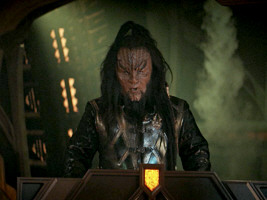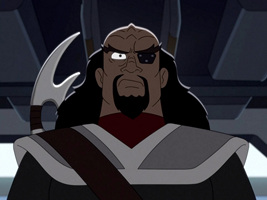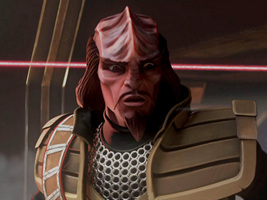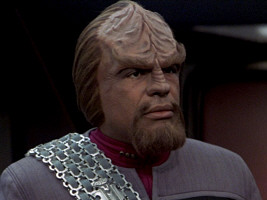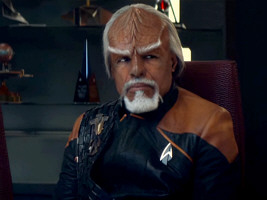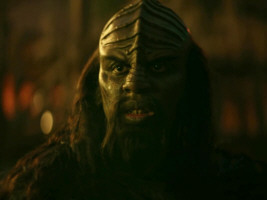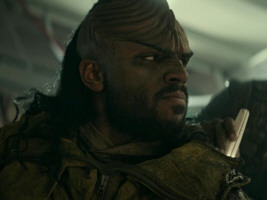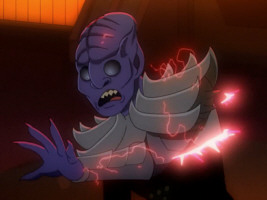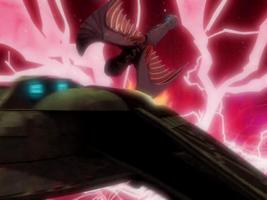Dealing with Discovery Klingons
 The redesign of the Klingons almost from scratch for Star Trek Discovery is the arguably most controversial artistic decision in the history of the franchise. Whether they criticize the new look and feel of the species for its clumsiness or for its disrespect of canon, many fans genuinely dislike it.
The redesign of the Klingons almost from scratch for Star Trek Discovery is the arguably most controversial artistic decision in the history of the franchise. Whether they criticize the new look and feel of the species for its clumsiness or for its disrespect of canon, many fans genuinely dislike it.
The people in charge quickly noticed that their creation was unpopular and changed the Klingons yet again after only one season. Most of them were given back their hair, and some new characters received a make-up and attire that might pass as "classic" at a first glance. In addition, the unrelatable Klingon starships of the first season were scrapped for the most part and replaced with a design that (despite being a lot bigger) resembles a classic D7 battlecruiser. Both design decisions, the hair and the D7, were even mentioned in dialogue and thereby became a part of the story, rather than being a merely creative decision we are supposed to ignore in suspension of disbelief. The apparent goal of the amendments was to bridge the enormous visual discrepancy between the reimagined Klingons and the species we know from classic Trek since the 1980's, and to allow the style of Discovery and of the previous shows to exist concurrently.
The Klingons, however, vanished after Discovery's second season. They were conspicuously absent from seasons 3 and 4 and also from Strange New Worlds season 1, which is clearly set in the same reimagined universe. Klingons did appear repeatedly in Lower Decks seasons 1-3, as well as in season 1 of Prodigy. Both animated series exclusively show classic Klingons, which is a no-brainer, considering that their visuals are firmly based on classic production design, with only insignificant exceptions.
This leaves Star Trek Picard as a series that might have shown Discovery Klingons. It was always clear that "Worf looks like Worf", as showrunner Terry Matalas promised on April 6, 2022, especially considering that Michael Dorn had announced he would not want to wear the new make-up. Season 3 accordingly features an aged "classic" Worf. But no other Klingon of any kind appear on the show.
Rather than speculating on the reasons for the absence of Klingons from recent live-action seasons, it is interesting to outline the options for how they may look once they show up again, and what the impact would be. Animated series are not included in the following considerations, as they have already made a decision in favor of the classic look, although it remains an option for them to show Discovery Klingons as well, should the according decision be made in a live-action show.
The following chapter addresses the options as of early 2023. You may want to skip to the updates to find out what actually happened.
Options
There are four options for future live-action episodes to depict Klingons, and particularly groups of more than one of their species. I include all of them, however illogical or unlikely they may appear. I only omit a possible option E: "No Klingons ever again".
For the sake of simplicity, I refer to the Klingons since "Star Trek: The Motion Picture" (TMP) as the "classic" or "old" ones. In cases where the Klingon look in TOS may matter as well, I explicitly include them in my considerations.
Option A: Classic only
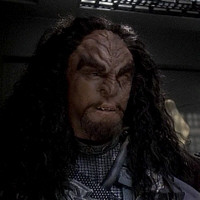 Considering that the new Klingons were not well received by many fans and that the classic ones are still a much more important staple of the franchise, the decision may be in favor of the latter. For Picard, this would make a lot of sense, considering that Worf has old-style make-up and the visual discrepancy would be odd if any other Klingons he met in season 3 looked totally different than he himself, and also totally different than any of the hundreds of members of his species he ever encountered on TNG and DS9. After all, he is the character with the most appearances in the franchise and belongs to the alien race with the most screen time. On the other hand, Picard will end after season 3, and there may be no need to show Klingons besides Worf at all.
Considering that the new Klingons were not well received by many fans and that the classic ones are still a much more important staple of the franchise, the decision may be in favor of the latter. For Picard, this would make a lot of sense, considering that Worf has old-style make-up and the visual discrepancy would be odd if any other Klingons he met in season 3 looked totally different than he himself, and also totally different than any of the hundreds of members of his species he ever encountered on TNG and DS9. After all, he is the character with the most appearances in the franchise and belongs to the alien race with the most screen time. On the other hand, Picard will end after season 3, and there may be no need to show Klingons besides Worf at all.
For Discovery, to replace the new Klingons with the old ones would create quite an intraseries visual discrepancy. There is one important reason why this likely won't happen. Discovery already made a deal of a much smaller change by explicitly addressing the fact that they got back their hair in season 2. It would require an according explanation for the Klingons to mutate yet again, especially in relation to firmly established characters such as L'Rell, Voq, Kol and T'Kuvma. Even though the USS Discovery is in the far future now and much seems possible, hinting at another political or even biological transformation of the species would be very contrived.
Is Strange New Worlds a candidate for showing classic Klingons? Considering that the series continues where Discovery left, the answer should be no. Moreover, with the series being set just a few years before TOS, there is another level of complexity because of the discrepancy between TOS and TMP Klingons. Although this issue has been resolved canonically, unlike the one about the Discovery redesign, it would add just too much confusion for SNW to switch to TMP Klingons (or even to TOS Klingons?), rather than showing the DIS version.
We could rule out option A for the series, if it were not for a leaked photo from March 2022 that allegedly shows a background actor with TMP-style make-up on the set of SNW season 2. If this is authentic, it could still mean that this guy is barely visible at all and/or is only a token classic Klingon.
Option B: Reboot only
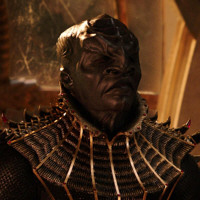 Even though the official story is a different one, Discovery was initially meant to be a total visual reboot, whose looks in comparison to classic Trek were allowed and perhaps even encouraged to be very different, to set the new series apart. If we still go with this original idea, Discovery's version is how all Klingons officially look now, in all live-action series, even though they were absent from recent seasons for some reason. Worf could be handwaved as a one-time exception, so the visual coherence with Picard would not be impaired too much. With this rationale, Discovery should most definitely return to exclusively the new look. That is, if the reasoning of them having been visually rebooted still holds.
Even though the official story is a different one, Discovery was initially meant to be a total visual reboot, whose looks in comparison to classic Trek were allowed and perhaps even encouraged to be very different, to set the new series apart. If we still go with this original idea, Discovery's version is how all Klingons officially look now, in all live-action series, even though they were absent from recent seasons for some reason. Worf could be handwaved as a one-time exception, so the visual coherence with Picard would not be impaired too much. With this rationale, Discovery should most definitely return to exclusively the new look. That is, if the reasoning of them having been visually rebooted still holds.
For Strange New Worlds, it too may seem like the most obvious solution to stick with the redesign, especially since the series takes place directly after the last Klingons, and exclusively new ones, were seen in season 2 of Discovery. SNW may be more respectful of the looks of TOS than DIS was, but the producers may argue that the issue of the Klingon look is messed up anyway at the time of TOS, so it wouldn't be a bad idea to ditch both TOS and TMP Klingons in favor of the DIS version. Also, it wouldn't unnecessarily confuse viewers that are new to Trek and only know the series since 2017. And since the SNW Enterprise is a much larger and much more powerful starship than the one of TOS, it may not even seem like a big deal if occasional adversaries of the era look different.
For PIC, option B may not be seriously considered, for the reasons already mentioned. The visual continuity not only with Worf but with the whole of 24th century Star Trek (TNG, DS9, VOY) would be lost for the benefit of aligning this series with a design decision at the beginning of Discovery.
However, the policy has changed since Discovery was created. Looks do matter since the second season; they were in the focus of interest or explicitly hinted at several times, breaking the fourth wall. Also, the trend to reimagine species has evidently stopped after DIS season 1. It would be odd if, of all species, the future Klingons appeared with the unloved Discovery-style make-up, and on all shows.
Option C: "Diverse"
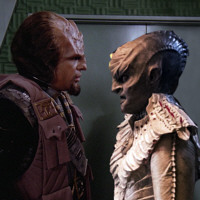 There are hints that visuals matter in the franchise (again), and that classic Klingons still exist besides Worf and the animated series. It is possible that the producers of current Star Trek series are going for something like a Grand Unified Theory, in the course of which they acknowledge the different looks of classic and Discovery Klingons and allow to show them side by side. If it happens, it may be at any point of the timeline, in any or all of the currently three live-action series. The Klingons as a diverse society is also a solution to the dilemma that is favored by many fans. Except that it isn't a solution.
There are hints that visuals matter in the franchise (again), and that classic Klingons still exist besides Worf and the animated series. It is possible that the producers of current Star Trek series are going for something like a Grand Unified Theory, in the course of which they acknowledge the different looks of classic and Discovery Klingons and allow to show them side by side. If it happens, it may be at any point of the timeline, in any or all of the currently three live-action series. The Klingons as a diverse society is also a solution to the dilemma that is favored by many fans. Except that it isn't a solution.
The Klingons were never diverse. In classic Trek, we saw exclusively TMP Klingons in ENT (with one notable exception), exclusively TOS Klingons in TOS and exclusively TMP Klingons on all later occasions. The discrepancy between these two was explained, albeit not completely consistently, in ENT: "Divergence", which is the already mentioned exception. There were no DIS Klingons at all in classic Trek (for obvious reasons) but also no classic Klingons at all on Discovery (so far). The statistics just don't support option C and can't be fixed retroactively, except perhaps with hundreds of new episodes showing the postulated new diversity at different points of the timeline.
No matter how desirable option C is, there is a good chance it will happen at some point in one show or another, with or without giving an explanation. Strange New Worlds may seem like a candidate, also considering the leaked photo of the TMP Klingon on the set of season 2. But there is the additional issue with TOS Klingons. Well, it may be an (awkward) option to include something like human looking "infiltrators" to SNW, to build a visual bridge not only to the TOS movies and 24th century Trek but also to TOS. I personally expect that Picard doesn't show us any Klingons besides the TMP version because of the endangered visual continuity with Worf.
Option C would require to issue some kind of creative directive to all shows (at least to all live-action shows). If this doesn't happen, we end up with the following option D.
Option D: Series-specific
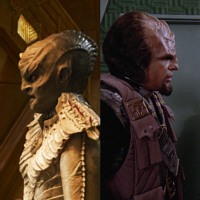 The considerations on the options A, B and C have shown different impacts on the currently three series. Perhaps the decision is or will be made on a case-by-case basis which visual standards apply to which series in the future. This would impair the overall visual continuity between the current live-action series. On the other hand, the people in charge of the series seem to consider the animated series fully canon, so there is a visual discrepancy already now that wouldn't become worse. The franchise effectively pursues option D since 2017.
The considerations on the options A, B and C have shown different impacts on the currently three series. Perhaps the decision is or will be made on a case-by-case basis which visual standards apply to which series in the future. This would impair the overall visual continuity between the current live-action series. On the other hand, the people in charge of the series seem to consider the animated series fully canon, so there is a visual discrepancy already now that wouldn't become worse. The franchise effectively pursues option D since 2017.
Anyway, Discovery may return to its (so far) proprietary version of Klingons, but it also seems imaginable in the 32nd century for Klingons to be more diverse. Strange New Worlds may have more freedom to choose its brand of Klingons if the series is not bound by decisions that were possibly unwisely made when Discovery was created. The show could emancipate itself from DIS. And it could try to bridge the visual gap, starting off with the style of DIS and ending with something that looks a bit more like TOS or at least the TOS movie era. For Picard, option D would simply mean that all other Klingons are classic ones like Worf. It is still another question what will happen in future series.
It is possible that option D is just a temporary solution in lack of a universal decision for the whole franchise.
Commentary
My personal opinion is that the unsuccessful Discovery Klingons should be gone for good. Yet, I think that it wouldn't really cause additional damage if they appeared in some form in Discovery's 32nd century. The dilemma is most obvious in Strange New Worlds, where no less than three Klingon looks would have to be considered, which is impossible to accomplish without causing even more issues. Perhaps the series should show no Klingons at all, although my gut feeling is they will definitely appear, perhaps as soon as in season 2 as the leak and the rumors seem to indicate. Regarding Picard, I just hope they don't jeopardize the status of the series as being mostly unaffected by the reimaginations made for Discovery.
The visual continuity of the franchise is most definitely messed up, not only with regard to classic Trek but also between the series that are currently on air. This is especially true if we also consider the two animated shows. As I already mentioned, option D to have series-specific Klingons may be just temporary. While I would hope for any future series to go with option A and show just the classic make-up, it is possible that the people in charge, as well as many fans, deem the "diverse" Klingon species the most attractive solution, as little sense as it makes statistically.
Update Notices
The U-turn in SNW
No Klingons besides Worf could be seen in the final season of Star Trek Picard. On the other hand, pre-reboot Klingons appear in the second season of Strange New Worlds, starting in "The Broken Circle". So far all of the many Klingons we see on the show are classic ones. Even though one or two have an elongated head like in Discovery, they otherwise don't look like that, as nose, chin and ears are concerned. There is no verbal cue either that the species ever looked any different.
The official explanation for the U-turn in Klingon design is that Strange New Worlds is a new series and takes the creative freedom to do some things differently than Discovery. While this sounds like the above option D prevails, it seems unlikely that the unpopular Disocvery Klingons will ever return in a new series, so this would be effectively option A. The decision to revert them to the classic look without an in-universe rationale may even allow us to disregard the Discovery Klingons altogether, unless we are just watching Discovery.
The multiverse option in LOW
In another possible paradigm shift, the series finale "The New Next Generation" of Lower Decks shows the first Discovery-style Klingon outside Discovery, along with a Discovery-style Bird-of-Prey (whose design was abandoned after DIS season 1). These are said to be "multiverse possibilities" enabled by the Schrödinger field. Their look is a real possibility, one that can exist and therefore does exist somewhere in the multiverse. What we see at the beginning of "The New Next Generation" means that distinct Discovery Klingons may indeed be a thing; they are not simply a real-world visual reimagination of familiar Klingons, unlike the continuity from classic Trek to DIS to SNW would require and unlike the official policy must have been so far.
So there are Discovery Klingons at some time in some universe. But does that mean Discovery takes place in a parallel universe? With the visual evidence from Lower Decks, we can confirm Discovery Klingons in at least one quantum reality. But that doesn't imply that they couldn't exist or have existed in our universe as well. It may not be possible to find a definite answer to the question. But we can look for further evidence (or for old evidence that needs to be reevaluated now that DIS make-up has to be taken into consideration).
- It speaks in favor of the existence of Discovery Klingons in our universe that there are various continuity ties between DIS and SNW, as well as between DIS and classic Trek, such as Pike, Spock, the Enterprise or the Klingon-Federation war. There are numerous other discrepancies besides the Klingons especially between classic Trek and DIS. Still, owing to the second law of thermodynamics the galactic history as shown in DIS couldn't possibly be similar if it took place in a quantum reality where Klingon biology (or the biology of all influential Klingons at some time) were extremely different in the first place. In other words, if we don't contest overall continuity, it requires a universe with both types of Klingons.
On the other hand, there is a new reason why DIS-Klingons would be more plausible if they did not exist in our universe.
- Statistical considerations do not support the idea of an uninterrupted continuity between classic Trek, DIS and SNW any more. All Klingons in Discovery without exception are proprietary. All Klingons in classic Trek and in SNW without exception are classic (or are Augments, whose ephemeral nature is sufficiently explained). Since it is no longer possible to pretend that DIS-Klingons are the same species in-universe, this becomes an extreme statistical dilemma. Where were all the DIS-Klingons prior to 2256 and after 2258? Where were all the classic Klingons between 2256 and 2258?
If we examine more closely what happens "The New Next Generation", there are further points to consider.
- In an attempt to dismiss the parallel universe theory, some fans argue that if the DIS-BoP exists only in a another quantum reality, so would the Sovereign class because the Cerritos gets transformed into one due to the very same phenomenon. But that particular Sovereign class (with nacelles of the California class!), just like every single mutation of the Cerritos inside the Schrödinger field, cannot possibly exist in our reality! In our universe, there is no Sovereign class with California nacelles, no Galaxy class named Cerritos and no Terran ship anyway. Every single one of the ship variations has to be from another quantum reality. So why shouldn't the same apply to the DIS-BoP, which is a far more extreme transformation? On the other hand, a Klingon sailing ship (VOY: "Barge of the Dead") or primitive proto-Klingons (TNG: "Genesis") as also seen in the episode do or did exist in some form in our universe, only at a different time. So it could be argued that "Klingon transformations" follow a different pattern than those of the Cerritos.
- The whole point of the scene with the DIS-Klingons in "The New Next Generation" is to demonstrate that whoever enters the Schrödinger field would mutate to someone or something "equivalent" from a parallel reality, as dubious as the science or logic of it is. If what we saw in Discovery is true, it is worth noting that the DIS-BoP is not what a regular BoP would look in another universe but a ship type that was used in parallel, until it was abandoned over a hundred years ago (after DIS season 1). Even more obviously, why would classic Klingons become DIS-Klingons if both of them existed in our universe, possibly at different times or in different regions? Well, in the multiverse, everything is still possible. However, the particular mutation that happens in the LOW episode would require a reality in which there are only DIS-BoPs and only DIS-Klingons, and which for some reason has a similar history as ours. In other words, it would not go along with the above reasoning that the second law of thermodynamics has to be obeyed. Once again, it is possible to object that proto-Klingons or sailors on an old wooden ship are not exactly "equivalent" to modern-day Klingons either. But a universe in which the species evolved more slowly is far more plausible than universes with one or two very different types of Klingons being nearly the same.
So there is some canon support for Discovery taking place in a different universe now - although the continuity ties to SNW and also to classic Trek are still strong. We may want to take this whole issue brought up in Lower Decks with a grain of salt but it gives rise to a still different interpretation of if and why DIS-Klingons are different and of how to deal with that. Mike McMahan tells us:
"Listen, I'm not gonna tell the fans how to respond to anything. If you watch you can see the timelines across different realities are all messed up. Was I being a little stinker with that moment and knowing what I was doing? Yeah. I'm not dumb. It's also not firmly [established]-another multiversal shift we saw is it turned into a Klingon sail barge. You can take that moment however you want, and talk to me about it in ten years [smiles]."
See Also
Discovery Klingons and Star Trek's Continuity - how different they really are and some more thoughts
The Visual Continuity of Star Trek - examples of if and how visual continuity was maintained through the generations






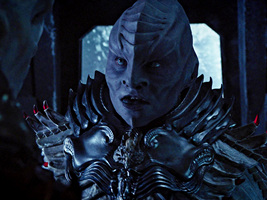
 L'Rell in DIS: "The Butcher's Knife Cares Not for the Lamb's Cry"
L'Rell in DIS: "The Butcher's Knife Cares Not for the Lamb's Cry"